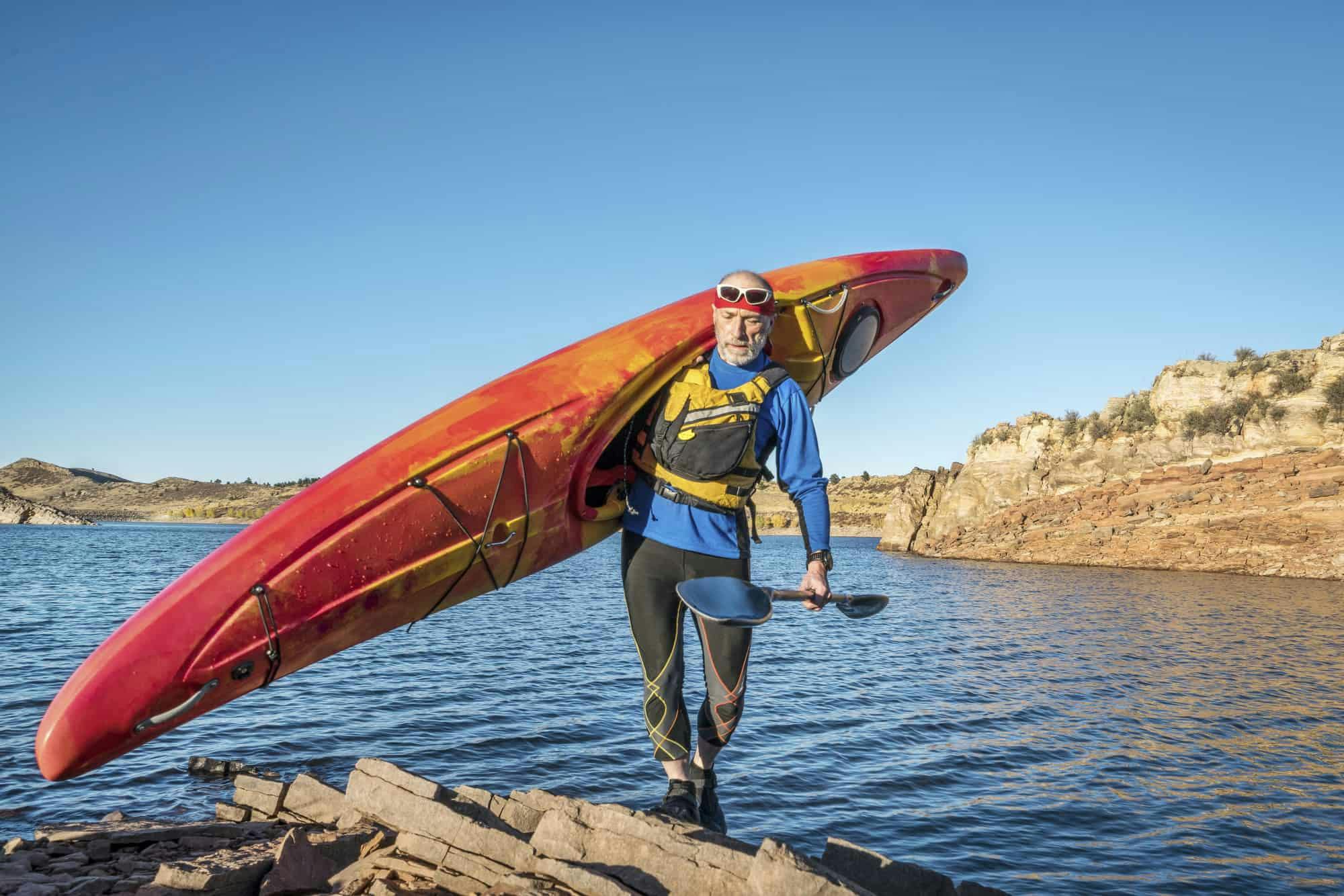
- Alabama
- Alaska
- Arizona
- Arkansas
- California
- Colorado
- Connecticut
- Delaware
- Florida
- Georgia
- Hawaii
- Idaho
- Illinois
- Indiana
- Iowa
- Kansas
- Kentucky
- Louisiana
- Maine
- Maryland
- Massachusetts
- Michigan
- Minnesota
- Mississippi
- Missouri
- Montana
- Nebraska
- Nevada
- New Hampshire
- New Jersey
- New Mexico
- New York
- North Carolina
- North Dakota
- Ohio
- Oklahoma
- Oregon
- Pennsylvania
- Rhode Island
- South Carolina
- South Dakota
- Tennessee
- Texas
- Utah
- Vermont
- Virginia
- Washington
- West Virginia
- Wisconsin
- Wyoming
Transport A Kayak: How To Lift And Carry A Kayak The Right Way?
How To Carry A Kayak?
There is nothing like a kayak. In addition to offering a unique perspective on the world, they provide adventures and experiences that can't be found on any other vessel. However, kayaking does have some drawbacks, and one of the biggest is carrying the kayak. Which are the best techniques for lifting a kayak?
When the kayak is light and small enough, it can be lifted and carried by one person. Otherwise, a friend can assist. Kayak carts are the best way to transport a kayak over land, and they can be stored inside the boat for use when portaging is necessary.
Owning a vessel of this type involves lifting and carrying it. You should understand the best methods and techniques for moving and lifting a kayak to ensure that it is not damaged and that you are not injured. Here are the best practices for lifting and carrying all kayaks.
Which Are The Best Methods For Carrying Kayaks?
People who own kayaks must carry them. The kayaker may have difficulty getting his boat from his vehicle to the water, especially if the boat is long. What are kayakers to do?
It is essential to use proper lifting techniques when carrying kayaks alone, with the help of another person if possible, or to use a kaya cart or trolley when carrying kayaks over longer distances.
Lifting the kayaks on your shoulders will allow you to carry them easily. It is easier to paddle a lighter or shorter kayak, though you may also be able to swim a heavier and longer kayak, depending on your strength.
It is ideal to enlist the help of a friend when lifting and transporting a kayak. Kayaks can be carried in this manner without causing damage to them, and the boat's load will be shared between two people—kayaks with handles at the bow and stern benefit from this method.
Another person can also carry them together. Two people can have two kayaks easily since kayaks are lightweight enough to be held with one arm and the other lifted by another person.
Transporting a kayak overland is far easier when using a kayak cart or trolley. Kayak carts are wheels and cradles that are designed to transport kayaks. A paddler pulls the kayak along by lifting the other end of the boat and securing the underside.
Rolling a kayak becomes much easier with two carts, and two coaches can be adapted with attachments to keep it stable over rough terrain.
The last and least desirable option is to drag your kayak along the ground. Kayaks are usually equipped with handles to be lifted and removed from either end.
Kayaks can be damaged if dragged, especially if they have a keel or a rudder. If needed, you can carry a plastic kayak over grass or sand, but a composite or fiberglass kayak does not need to be dragged.
These methods effectively transport a kayak over land, but there are a few other details to be explored, like lifting a kayak and removing a kayak from a vehicle. This is an excellent time to talk about lifting and moving kayaks, and I would like to touch on these topics.
What You Need To Know About Moving Small Kayaks
Shorter kayaks are easier to lift and carry than longer boats, but some methods work best for shorter kayaks.
It is not always the case that shorter kayaks are lighter, and it is a fundamental rule to remember. Small kayaks are not necessarily lightweight just because they are small. It is not so much the size of the kayak as the materials it is made from determining the boat's weight.
Smaller kayaks are far more maneuverable and are far less cumbersome to transport. As these kayaks are narrower, they are easier to carry over long distances and lift onto one's shoulders.
A smaller kayak can be lifted onto your shoulder by bending your knees, lifting the kayak onto your thighs, and using the lip of the cockpit, rolling it onto your shoulder. Use both hands to support the kayak, or if you are strong enough, use one arm to carry it.
Before lifting your kayak, you should strap your paddle to the kayak to carry it with both hands.
You should be cautious once the boat has been lifted, as it is easy to trip when carrying a heavy boat, and it is even easier to bump into obstacles and people if you are not careful.
You should be able to carry your kayak for as long as your strength allows; however, alternative methods exist.
A friend can easily carry small kayaks, and kayak carts can be used to move a small kayak over rough terrain or long distances. Pulling a coach with a short kayak will be uncomfortable because you must bend over to move it comfortably.
A Guide To Lift And Carrying Inflatable Kayak
It is one thing to lift and carry a small or short kayak, but raising and having a large kayak and taking a longer vessel is quite another. The same is true for kayaks loaded with gear and kayaks that are very heavy and robust.
Lifting a long, heavy, or loaded kayak is impossible with only one person. As a result, most people cannot move their kayaks over the ground by rolling them onto their shoulders.
A kayak like this can be moved with the help of another person. When the handles on the kayak are strong enough, even a very heavily loaded kayak can be handled by two people.
Using a kayak cart is your only real option if you're on your own. Longer kayaks are made to be moved easily using these carts and do their job well.
RailBlaza's C-Tug cart is a perfect choice. It's improbable that the carts will slip off your kayak, and the adjustable cradle fits almost every kayak type and size.
A kayak cart is easy, safe, and saves you the effort and strain of lifting a kayak off the ground or onto your shoulder. Kayaks can also be moved easily with these carts, allowing them to be rolled straight into the water and launched quickly.
For very long or heavy kayaks, a second cart may be necessary to ensure stability while moving over land and support the boat and its cargo well over challenging terrain. Overland, using a cart, it is easiest to lift and carry a kayak.
Boats made of durable materials can also be dragged. Composite and fiberglass boats shouldn't be pulled for any reason. Boats that can withstand short drags over soft ground such as sand or grass won't be damaged too much.
Kayak Carts And Trolleys
Using a cart or trolley is the most convenient and straightforward method when moving a kayak over land. The kayak cart market is crowded nowadays, and several models are available. All of them are better than nothing; however, some models are better than others.
To move your kayak as smoothly and efficiently as possible, you must choose the right type of kayak cart. When selecting a kayak cart, consider your kayak's style and design, its size, wheels, and the terrain you will traverse.
Kayak carts can be categorized into four types: scupper hole carts, cradle and strap carts, double rail carts, and end carts. It comes down to your preference and your gear to determine which coach is best for you.
Scupper hole carts are rods attached that pass through the scupper holes in a kayak. Scupper holes are not on all kayaks, but if yours is one of them, these carts can come in handy. No straps or ropes are needed to keep this cart stable under the kayak, as the scupper holes provide all of the necessary support.
Carts with straps and cradles are also a good option. Kayak carts are easy to use and suitable for most kayak types. Kayak carts of this type tend to be the smallest and lightest on the market. They can easily and quickly be broken down to fit in your kayak hatch, eliminating the need for a trip to the car and allowing you to keep the cart close at hand.
There are different types of double rail carts. Almost any type of kayak can be accommodated with this cart, which is straightforward. There's nothing more than strapping the kayak down to the cart rails. It is easy to use double rail carts in pairs for long or heavy kayaks.
End carts are very effective but can only be used on compatible kayaks. A kayak can be tucked within this cart rather than resting on it since its stern fits over the hoop. A kayak can now be pulled along very quickly while remaining firmly attached to the cart, as it is a highly secure and stable cart that is ideal for very rugged terrain.
One person can quickly move their kayak using a kayak cart without damaging the vessel or causing injury to themselves or the ship. Convenient, lightweight, simple to use, and highly effective, these carts are a great option.
Kayak Carts Can Be Used For Portaging
In addition to improving how they carry and lift their kayak, many paddlers seek to improve how they raise and have their boats. In some cases, moving a kayak over land is the only way to continue an excursion on the water, so many wonders if using a kayak cart is the right choice.
Certainly, kayak carts can be used for portaging kayaks. The only thing to consider is whether or not the cart is small enough to be carried with you on a kayaking trip. If it is, then it is an ideal mode of transport.
Most cradle and strap kayak carts can be broken down into small components stored within a kayak's hatch. The plastic varieties are usually light and add little weight to your vessel.
Using a kayak cart for portage, crossing those frustrating dry sections, or coming ashore to camp for the night is simple when your cart can be stored in your kayak or backpack.
Conclusion
When lifting and carrying shorter or lighter kayak, you can put the boat on your shoulder and carry it that way. It is best to move longer vessels with another person, but the ideal method for moving all types of kayaks is to use a kayak cart. Rolling a kayak with carts is easy, simple, and effective.
The next time you take your kayak out, try various lifting and carrying it to find out what works best for you. There are many options and methods, but many are kayak-specific and depend on how physically fit you are.
Getting to the water quickly won't be a chore when you discover the most effective method for moving your kayak over land.
Frequently Asked Questions
Can you carry a kayak easily?
Taking a kayak on the road is not difficult, but you should ensure that your kayak is loaded properly onto your vehicle to ensure its safety. But first, you need to learn how to carry a kayak.
How to carry a kayak?
Place the kayak on the ground in front of you. The bow, or the front of the kayak, should face the direction you want to travel. Stand beside the cockpit. Squat down and bend your knees. Grab the cockpit side that is closest to you. Keep your knees bent while sliding the kayak onto your thighs. Go to the opposite side of the cockpit. Stand up while lifting the kayak. Place the kayak on your shoulder and rotate it. Place the rim on your shoulder and let it rest there.
Is it necessary to use kayak trolleys?
Kayak trolleys are an absolute necessity in most situations. You can transport your kayak safely to the water and more secluded launching locations with their help.
How do you use a folding kayak cart?
A folding cart is usually made of heavy-duty aluminum and works the same way as any other cart. Place the trolley in position, then lift your kayak and lower it. Once you've secured the straps, you're ready to go.











